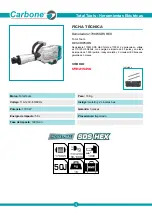
18
Operation
Notes on Operation
An initial bore is required for cut-outs.
When cutting for a longer period of time or when processing
harder workpieces, apply cutting oil to the cutting shafts to cool
and to protect the cutting shaft.
Always hold the cutting shaft vertically against the workpiece.
Do not use force when pushing the cutting shaft against the
workpiece. If you are not satisfied with the result, check the cut-
ting shaft for wear.
Lead the tool to the workpiece only when it is switched on.
Do not tilt the tool to the side.
Work with a lower feed rate when cutting curves to prevent
jamming of the driving engine (danger of kickback).
Do not use the impact drill function when operating the sheet
metal nibbler attachment.
Replacing the Cutting Shaft
Replace a damaged or worn cutting shaft with a new one of the
same size and dimensions to maintain a high cutting quality grade
and to prevent injuries. A spare cutting shaft (6) is provided with this
tool. It can be replaced as follow:
1. Use the Allen key (7) to loosen the two fixing screws (8) of the
cutting shaft holders (2) and remove the cutting shaft holders
(fig. 4).
2. Carefully remove the coil spring from the cover (9). Then remove
the cover.
3. Use the spanner and Allen key to release the fixing screw and
nut for the cutting shaft. Remove the cutting shaft (fig. 5).
4. Lubricate the sliding block with machine grease.





































